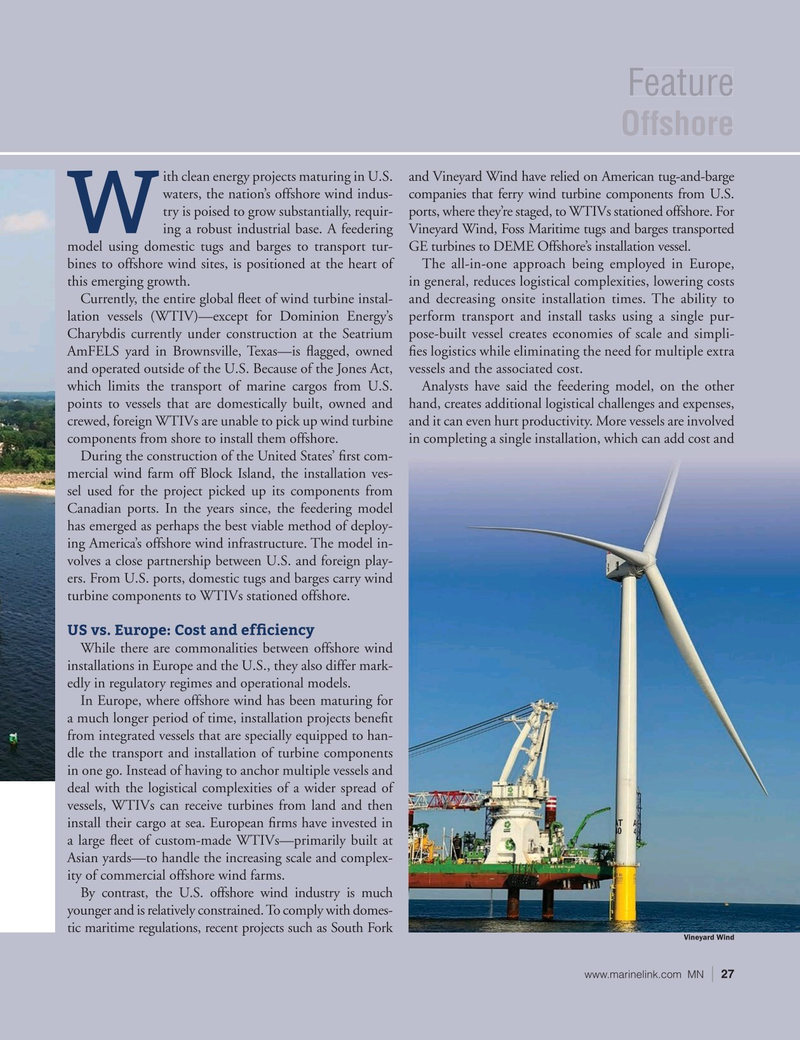
Page 27: of Marine News Magazine (October 2024)
Read this page in Pdf, Flash or Html5 edition of October 2024 Marine News Magazine
Feature
Offshore ith clean energy projects maturing in U.S. and Vineyard Wind have relied on American tug-and-barge waters, the nation’s offshore wind indus- companies that ferry wind turbine components from U.S. try is poised to grow substantially, requir- ports, where they’re staged, to WTIVs stationed offshore. For
W ing a robust industrial base. A feedering Vineyard Wind, Foss Maritime tugs and barges transported model using domestic tugs and barges to transport tur- GE turbines to DEME Offshore’s installation vessel.
bines to offshore wind sites, is positioned at the heart of The all-in-one approach being employed in Europe, this emerging growth. in general, reduces logistical complexities, lowering costs
Currently, the entire global ? eet of wind turbine instal- and decreasing onsite installation times. The ability to lation vessels (WTIV)—except for Dominion Energy’s perform transport and install tasks using a single pur-
Charybdis currently under construction at the Seatrium pose-built vessel creates economies of scale and simpli-
AmFELS yard in Brownsville, Texas—is ? agged, owned ? es logistics while eliminating the need for multiple extra and operated outside of the U.S. Because of the Jones Act, vessels and the associated cost. which limits the transport of marine cargos from U.S. Analysts have said the feedering model, on the other points to vessels that are domestically built, owned and hand, creates additional logistical challenges and expenses, crewed, foreign WTIVs are unable to pick up wind turbine and it can even hurt productivity. More vessels are involved components from shore to install them offshore. in completing a single installation, which can add cost and
During the construction of the United States’ ? rst com- mercial wind farm off Block Island, the installation ves- sel used for the project picked up its components from
Canadian ports. In the years since, the feedering model has emerged as perhaps the best viable method of deploy- ing America’s offshore wind infrastructure. The model in- volves a close partnership between U.S. and foreign play- ers. From U.S. ports, domestic tugs and barges carry wind turbine components to WTIVs stationed offshore.
US vs. Europe: Cost and ef? ciency
While there are commonalities between offshore wind installations in Europe and the U.S., they also differ mark- edly in regulatory regimes and operational models.
In Europe, where offshore wind has been maturing for a much longer period of time, installation projects bene? t from integrated vessels that are specially equipped to han- dle the transport and installation of turbine components in one go. Instead of having to anchor multiple vessels and deal with the logistical complexities of a wider spread of vessels, WTIVs can receive turbines from land and then install their cargo at sea. European ? rms have invested in a large ? eet of custom-made WTIVs—primarily built at
Asian yards—to handle the increasing scale and complex- ity of commercial offshore wind farms.
By contrast, the U.S. offshore wind industry is much younger and is relatively constrained. To comply with domes- tic maritime regulations, recent projects such as South Fork
Vineyard Wind www.marinelink.com MN 27|

 26
26

 28
28
